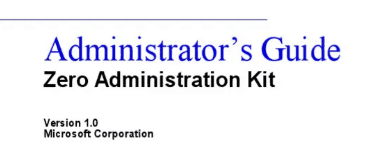Definition of Zero Administration Kit (ZAK) in Network Encyclopedia. (deprecated)
What is Zero Administration Kit (ZAK)
ZAK (Zero Administration Kit) is a tool collection, methodologies, and guidelines for Microsoft Windows NT Workstation 4 that network administrators can use to implement policy-based management of Windows NT–based networks.

You can use the Zero Administration Kit (ZAK) to:
- Manage the configuration of users’ desktops from a central location without having to visit each computer. You can specify exactly which applications the user can run, the appearance of the desktop, and where user data will be saved.
- Restrict local access to users’ desktops. You can lock down the desktops to prevent users from performing actions that can result in costly help-desk calls, such as installing unapproved applications or modifying critical system files.
- Configure applications and data to be stored on network servers. You can achieve improved security by downloading applications from the network, and you can use local hard drives for caching to ensure good performance. This facilitates upgrading of applications and centralized backup.
How Does ZAK work
The Zero Administration Kit (ZAK) uses the security of the NTFS file system along with system policies and user profiles. You can use the predefined set of system policies to override the local default settings, and you can use standard user profiles to configure and manage users’ desktops from a central location. The Zero Administration Kit includes the two following preconfigured modes of operation. (Advanced administrators can create other custom network configurations.)
- TaskStation Mode: A desktop configuration for a “task-oriented” user such as a bank teller or a data entry person. This mode is ideal for users who require access to only one line-of-business application. TaskStation Mode completely locks down users’ desktops and boots directly into Microsoft Internet Explorer or a specified application. The user has no access to the Microsoft Windows Start button, taskbar, Task Manager, Control Panel, file system, or context menus.
- AppStation Mode: A desktop configuration for typical “knowledge workers” who use three or four business applications every day but lack the knowledge and experience to configure or troubleshoot the system or install other applications. This mode provides users with only the applications they need for their jobs via a constrained Windows interface. The user has no access to Task Manager, Control Panel, the file system, or context menus.
TIP
Microsoft TechNet includes a self-paced Hypertext Markup Language (HTML) course called “Implementing the MS Zero Administration Kit for Windows NT Workstation 4.0” (course 979), which is a great resource for learning about how to implement and deploy the Zero Administration Kit.